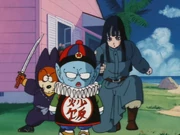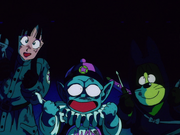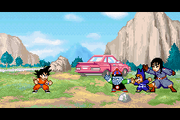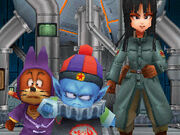The Pilaf Gang is a group run by Emperor Pilaf that tries to obtain the Dragon Balls for Pilaf, so he can rule Earth.
History

The Pilaf Gang
Emperor Pilaf is a short imp who desires to take over the world using the Dragon Balls, having many dreams of ruling the world. His two most significant henchmen are Shu and Mai. It is implied a couple of times early in the series that he has other minions as well, but they are unseen. One notable thing of Pilaf, is that he has a disposable amount of resources. The original base for his forces was his castle in the Diablo Desert.

The Pilaf Gang about to use their new Pilaf Machines
When Goku turned into a Great Ape and destroyed it, he got a new base which was a flying fortress, which was later shot down by Colonel Silver's troops. One significant thing they later acquire is the Pilaf Machines, which are giant battle robots they use to fight Goku making them a bit more closer to Goku's strength in battle.

The Pilaf Gang in Mystical Adventure
The legendary King Piccolo was released from his prison by Pilaf, which ultimately backfired when he took over and made his own forces. The Pilaf forces return to interrupt Goku and Chi-Chi a couple times on their quest for the Bancho Fan. In the video game Dragon Ball Z: Attack of the Saiyans, it is implied that Pilaf's Castle was rebuilt sometime after the Piccolo Jr. Saga.

The Pilaf Gang in Dragon Ball GT
Pilaf and the rest are shown still together in Dragon Ball GT and accidently use the Black Star Dragon Balls to turn Goku into a kid. Pilaf, Shu and Mai were later seen near their castle's ruins during the episode "Piccolo's Decision" when Goku took them to New Planet Plant before the Earth's explosion.
Video game appearances

Goku confronts the Pilaf Gang in Advanced Adventure
The Pilaf Gang appears in Dragon Ball: Shenron no Nazo, Dragon Ball Z: Buu's Fury, Dragon Ball GT: Transformation, and Dragon Ball: Origins.
Using their combined Pilaf Machine, the Pilaf Gang is a boss in Dragon Ball 3: Gokuden, Dragon Ball Z: Super Gokuden: Totsugeki-Hen, Dragon Ball: Advanced Adventure, Dragon Ball: Origins 2, and Dragon Ball Z: Attack of the Saiyans. The Pilaf Machine is a playable fighter in the Japanese and European Wii versions of Dragon Ball Z: Budokai Tenkaichi 2, as well as in all versions of Dragon Ball Z: Budokai Tenkaichi 3.
Also, a group very similar to the Pilaf Gang appears in Dragon Ball Online, the Paella Gang led by Paella.
Dragon Ball: Origins series

The Pilaf Gang in Dragon Ball: Origins 2
In Dragon Ball: Origins, in the bonus level 6-5, Pilaf rebuilds his castle and attempts to eliminate Goku before he becomes too much of an obstacle. In the bonus level 6-6: "Pilaf Must Be Stopped", after the 21st World Martial Arts Tournament, the Pilaf Gang gets Ranfan to join them in their rebuilt castle, and they terrorize a nearby village together before being stopped by Goku.
In Dragon Ball: Origins 2, in the bonus level 8-4, the Pilaf Gang kidnap Senbei Norimaki and Turbo Norimaki, and oblige them to repair their Flying Fortress and Pilaf Machines. In sub-episode 8-6: "Pilaf and Red Ribbon", the Pilaf Gang hire Colonel Violet to lead them to the Red Ribbon Army Headquarters' control room and find a surviving Red Ribbon Battle Jacket; Pilaf using the Battle Jacket and his two henchmen using their Pilaf Machines are defeated shortly later by Goku. In the bonus level 8-7, they get King Nikochan and his servant to repair and improve their flying fortress' nuclear reactor before confronting Goku, but they are defeated once again. This bonus level ends with Pilaf telling that he needs to find a fighter stronger than Goku, and then a flashforward shows Pilaf finding the Electric Rice Cooker where King Piccolo is sealed.
Members
Main Members
- Emperor Pilaf
- Mai
- Shu
- Unnamed spy #1 – Mentioned in "The Emperor's Quest" when he sent a message saying that he spotted a glow in Skull Valley just before he disappeared and that may possibly be another Dragon Ball.
- Unnamed spy #2 - This spy called Pilaf on the telephone to tell him about Master Roshi in the episode "The Nimbus Cloud of Roshi".
Allies
- Ranfan[1]
- Master Shen[3]
- General Tao[3]
- Colonel Violet[2]
- King Nikochan and his servant[2]
- King Piccolo
- Piano
- Tambourine
- Cymbal
- Buggy[4]
Trivia
- The Pilaf Gang are a reference to a classic anime cliche of recurring comedic villain trios that originally spawned from the Time Bokan series.
Gallery
References
- ↑ 1.0 1.1 Dragon Ball: Origins, 2008
- ↑ 2.0 2.1 2.2 2.3 Dragon Ball: Origins, 2010
- ↑ 3.0 3.1 3.2 Dragon Ball: Mystical Adventure, 1988
- ↑ Cross Epoch, 2006
| Pilaf Gang | |||||||||||
|---|---|---|---|---|---|---|---|---|---|---|---|
| Members | |||||||||||
| Affiliates |
| ||||||||||
| Related Articles |
| ||||||||||
















































